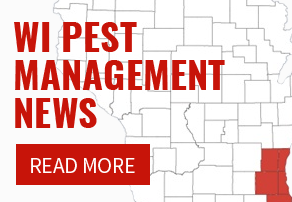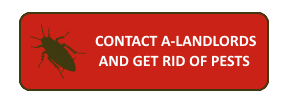Milwaukee Wasp Exterminator
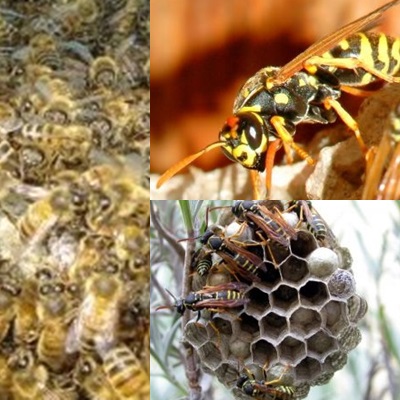 How to Eradicate Wasp, Bee, and Hornet Infestations
How to Eradicate Wasp, Bee, and Hornet Infestations
Wasp exterminators from A-Landlords can help eliminate wasp nests no matter how difficult they are to access. When you start seeing wasps around your Milwaukee residence, they are probably nesting in your roof. The pest control experts at A-Landlords will quickly and efficiently remove wasps, bees and hornets from your home or business. Our bee removal service will fully dispose of hives and nests residing in and around your buildings.
Identifying Wasps Versus Bees and At-Home Remedies
Trouble identifying whether you have a wasp or bee infestation? There are some easy steps to take to identify a wasp versus a bee. Things you want to look for are size, color variations, nest locations, and shape of the nest. All of these factors can help you identify whether they are foes or friends and help you eliminate your infestation.
In Milwaukee, Wauwatosa and West Allis, the three types of wasps most likely to cause trouble are Bald-Faced Hornets, Yellow Jackets (commonly mistaken for bees) and Paper Wasps.
Milwaukee Zip Codes We Service
| 53172 | 53202 | 53203 | 53204 | 53205 |
| 53206 | 53207 | 53208 | 53209 | 53210 |
| 53211 | 53212 | 53213 | 53214 | 53215 |
| 53216 | 53217 | 53218 | 53219 | 53220 |
| 53221 | 53222 | 53223 | 53224 | 53225 |
| 53226 | 53227 | 53228 | 53233 | 53235 |
Bald-Faced HornetsBaldfaced Hornets have a stout, black body with distinctive white striping around their head, abdomen and stinger. These pests are extremely aggressive and will sting without hesitation if threatened. Once stung, the Baldfaced Hornet will continue to sting you until it is killed or you manage to get away from it. How to Identify Bald-faced HornetsBald-faced hornets happen to be the largest type of wasp. They are anywhere from 1/2" to 3/4" long. Their most identifying characteristic is their color variation though. Hornets have black bodies and they tend to have white markings on their head and thorax. Nests are generally located in treetops, on the sides of houses or buildings, and under eaves. The hornet’s nest’s most defining feature is its shape which looks like a football. They also have a grayish color and a papery appearance. |
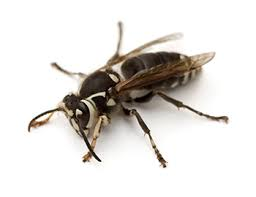 |
Yellow JacketsThe Yellow Jacket has yellow and black stripes (like a bee) but it’s in the wasp family. Unlike bees, Yellow Jackets have a more slender, hairless body. They are much more aggressive than honey bees. Their nests are an upside-down teardrop-shape with a a single hole in the bottom for them to exist and enter. Nests can be found in trees, shrubs, under decks or high in the eaves of homes and buildings. How to Identify Yellow JacketsThe yellow jacket is commonly mistaken for bees. However, they greatly differ and fall under the wasp family. The yellow jacket tends to be 1/2 inch long, yellow and black in body coloration, and their faces generally have some type of yellow or white markings. They also have black antennae with shorter legs than bees. They typically tend to build their nest in trees, shrubs, walls, cavities in the ground, or even man-made structures. Their nests are usually grayish-brown in color and happen to have a papery appearance. |
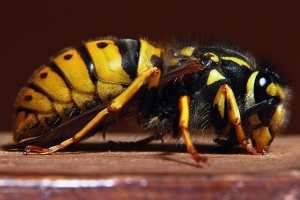 |
Paper WaspsPaper Wasps have a similar coloration to yellow jackets but with a slim body. They nest in eave peaks, behind shutters, under decks, in gas grills, on light fixtures, etc. Their nests are small and can be hard to find. Paper wasps can sting repeatedly. How to Identify Paper WaspsPaper wasps tend to be 1/2" long. Their color can vary from dark brown to reddish-orange, and they have black wings with yellow markings. They have a long slender body shape, with long legs. Their nests tend to be located in sheltered areas, such as door frames, windowsills, open pipes, under eaves, beneath decks or porches, and inside shrubs. The nest’s defining feature is its shape which tends to look like an umbrella. Their nest also displays exposed combs. |
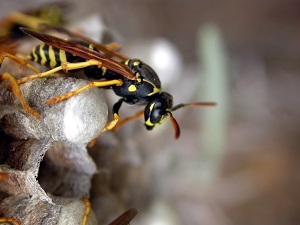 |
Wisconsin Bee, Wasp, and Hornet Pest Control Services Keep Your Family Safe
Our professional wasp and bee exterminators from A-Landlords remove bee & wasp nests and spray liquid insecticide on all the areas where stinging insects typically build their nests. Gutters, eaves, shutters, and decks are among the most common places to find hives and nests. The insecticide is long-lasting, invisible and kills insects on contact. The EPA-approved wasp removal treatment is safe and odorless in its dry state. Since most places wasps like to build nests are in protected areas away from the elements, the residue will last for a long time.
Identifying Bees in Milwaukee
How to Identify Bumble Bees
The Bumble Bee is typically 3/8" to 1/2" in length. The main difference between a bumble bee and a yellow jacket is that the bee’s body is covered in fur giving them a fuzzy appearance. They do not have much color variation, they are just black and yellow. Even their legs have hair follicles on them. Nests location can vary from underground to up in the trees. Their nest size tends to be smaller than honey bees due to the size of the colony that lives within it.
How to Identify Honey Bees
Honey Bees are about 1/2" in length. Like the bumble bee, its body is also covered in fur. The main difference is noticeable in its three parts. The honey bee's body is comprised of its head, thorax, and abdomen. Other features you might notice about the honey bee are that it has jointed legs and a it has a hard exoskeleton. Their nests are located in areas which flourish in pollen and/or nectar. Their nests are going to be significantly larger than the Bumble bee due to the size of the colony needed to produce the honey.
Bumble Bees: Friend or Foe?
Bumble bees live in colonies and unlike wasps and hornets, are reluctant to sting. They will defend their nest if provoked, but in most cases bumble bees are a sign of a healthy ecosystem. Bees pollinate flowers, shrubs and trees which keep your yard beautiful and fragrant. It is best not to have bumble bees exterminated unless their nest is inconveniently located. Call our Milwaukee bee exterminators for a quick and affordable solution. Or see our other pest control services.
At Home Remedies For Bee and Wasp Infestations
Several steps that one can take to help prevent a wasp or bee invasion
- Seal all open entry points to your home, these include:
- Cracks around windows or door frames
- Loose or torn screens on windows
- Loose siding and any unsealed vents
- Build or buy a fake nest and hang it in your tree
- Leave cucumber peels around your yard- bees do not like the acidic properties of cucumbers
Inexpensive solutions to eradicating your wasp or bee problem
- Build a fire under the nest. The hive will fill with smoke and suffocate the bees.
- Make a solution of water and dish soap and then pour it into the wasp hive. This coats the wasp wings making them unable to fly eventually drowning them in the remainder of the dish soap solution.
- Take a heavy-duty shop vac to the hive and suck out all of the wasps.
- Remove all old nests during winter, this sometimes prevents them from returning in future years.
Maintain Caution While Eradicating Bees and Wasps
One should use caution when trying to use any of these solutions. Although these techniques do kill certain bees, they may not always be safe. You may risk getting stung when going near a colony, which is especially dangerous if you are allergic. Sometimes killing one wasp can send off pheromones which attract more, worsening the infestation in your house.
The professionals at A-Landlords can access any wasp, hornet, or bee’s nest whether in your gutters, basement, attic, or roof. We will spray the treated area with a reliable insecticide, preventing future infestation. Don’t waste money on bug sprays or risk getting stung when our professional bee exterminators do the job for an affordable rate. If you suspect there’s a hive in your house, call our Milwaukee exterminators today!
A-Landlords provides wasp control services in the cities of Yorkville, Wind Point, Mount Pleasant, Caledonia, Sturtevant, Union Grove, Oak Creek, Franklin, Burlington, Racine, and beyond.









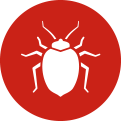 Bed Bug
Bed Bug Ant
Ant Roach
Roach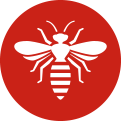 Wasp
Wasp Spider
Spider Rodent
Rodent